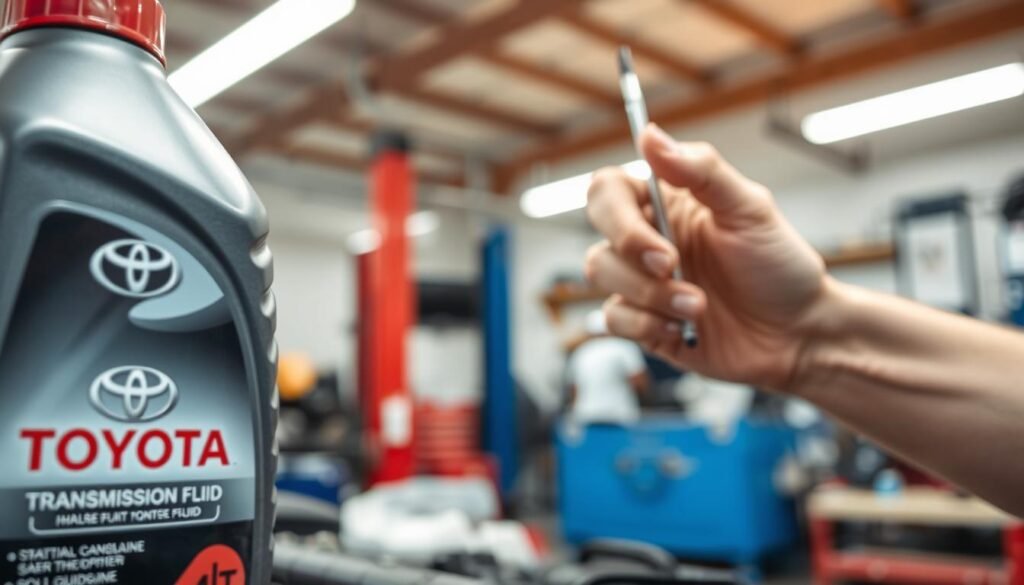Toyota Transmission Fluid Change Better Guide
Want to know how to toyota transmission fluid change? This task is crucial for your car’s top performance.
It keeps the transmission system running smoothly with proper lubrication. Knowing why transmission fluid matters helps keep your car running well for a long time.
We’ll show you why regular service of your Toyota’s transmission is important and how often to change the fluid.
You’ll learn the basic steps for doing the change yourself. We’ll also explain the difference between changing the fluid and flushing it.
By the end, you’ll know how to keep your Toyota’s transmission in great shape. This protects your investment and makes driving better.
What is Transmission Fluid?
Transmission fluid plays a key role in your vehicle’s transmission system. It keeps everything running smoothly and efficiently.
Getting to know how transmission fluid works helps in taking good care of your car.
What’s The Role of Transmission Fluid?
Transmission fluid has several jobs like lubricating parts, cooling the transmission, and keeping it clean.
By reducing friction, it helps transmissions last longer and shift gears more smoothly. This boosts your car’s performance.
Types of Transmission Fluid
Different vehicles need different types of fluid. The automatic transmission fluid (ATF) is very common for automatic vehicles.
For example, Toyota has its special WS fluid for its cars. Make sure to check your owner’s manual to pick the right fluid.
What is a Toyota Transmission Fluid Change?
Changing the transmission fluid in a Toyota is crucial for keeping your car running well. This service involves removing some of the old fluid and putting in new fluid.
It also includes changing the transmission filter. This helps your car run smoothly and keeps the transmission working for a long time.
A transmission fluid flush, however, is a step up from a simple change. It gets rid of almost all the old fluid.
This is best for cars that have really dirty fluid. Knowing the difference helps you choose the right service for your car.
Differences Between Fluid Change and Fluid Flush
| Aspect | Transmission Fluid Change | Transmission Fluid Flush |
|---|---|---|
| Fluid Removal | 30-40% of old fluid is removed | Nearly 100% of old fluid is removed |
| Filter Replacement | Includes new transmission filter | No filter replacement |
| Purpose | Routine maintenance | Intensive cleaning for heavy contamination |
| Frequency | Regular intervals per manufacturer recommendations | As needed, based on transmission condition |
How Often Should You Change Toyota Transmission Fluid?
Knowing when to change your Toyota’s transmission fluid is key to keeping your transmission healthy. Many owners forget how important regular changes are.
By following what the manufacturer says, your transmission will work better and last longer.
The right time to change the fluid depends on a few guidelines that help your car run well.
Manufacturer Recommendations
Looking at your car’s manual gives you the needed info on when to change the fluid. For most Toyota cars, changing the fluid every 30,000 to 100,000 miles is what’s suggested.
Even though some new models have “lifetime” fluid, getting it changed now and then can still make a difference. It helps your transmission perform better and last longer.
Factors That Influence Frequency of Changes
Different things can affect when you need to change your Toyota’s transmission fluid.
Things like towing heavy stuff, driving a lot in busy traffic, or in very hot or cold weather mean you might need to change the fluid more often.
These situations make the transmission work harder, which can make the fluid wear out faster.
Keeping an eye on the fluid’s condition and level helps figure out how often it needs changing.

Toyota Transmission Fluid Change Process
The Toyota transmission fluid change process includes several key steps. Each step makes sure your vehicle works smoothly.
It also helps keep your transmission in good shape and boosts your car’s performance. Knowing the right way to change the fluid saves you time and money later on.
Steps For a Successful Change
- Park your vehicle on a level surface to ensure accurate fluid drainage.
- Locate the drain plug and remove it to allow the old fluid to drain into a suitable container.
- Once drained, remove the transmission pan to access the filter. Be cautious, as some fluid may still be in the pan.
- Remove the old filter and replace it with a new one, following the manufacturer’s specifications.
- Clean the transmission pan thoroughly before reinstalling it to prevent contamination.
- Reinsert the drain plug and tighten securely to avoid leaks.
- Refill the transmission with new Toyota-recommended fluid, ensuring you add the correct type and amount as specified in your owner’s manual.
- Start your vehicle and check for leaks around the pan and drain plug.

By following these clear steps, you can ensure a smooth change. This will keep your Toyota transmission in top shape.
Always check your car’s manual for any special instructions specific to your model.
How To Check Your Toyota Transmission Fluid?
Regular checks on your Toyota’s transmission fluid are key to keeping it running well. Learning how to check this fluid lets you catch problems early.
This involves looking at the fluid’s level and its condition to see if maintenance or a replacement is needed.
Checking The Fluid Level and Condition
Start by parking your vehicle on a flat area and turn on the engine. Let it warm up for a more precise reading.
You’ll find the transmission dipstick near the engine’s rear. Pull it out and clean it off with a rag that doesn’t leave lint behind.
Next, put the dipstick back in completely, then take it out again. Examine the dipstick’s marks to see if the fluid is at the right level. It should fall within a certain range.
Healthy transmission fluid looks pinkish-red. Dark or burnt-looking fluid means it’s in bad shape and needs changing.

Checking the fluid level and its condition regularly helps your transmission last longer.
This task is crucial for taking good care of your vehicle. Always check your owner’s manual for details specific to your model.
Signs You Need a Transmission Fluid Change
Noticing the signs of low transmission fluid is key to keeping your car running well. Unusual grinding noises while driving could mean not enough fluid.
If gears slip, it’s time to check and possibly change the fluid to avoid bigger problems. Delayed shifting suggests low fluid levels too.
Your car might be slow to switch gears, needing quick action. Excessive vibrations during use also signal transmission troubles.
Spotting any of these signs, or seeing discolored fluid, means it’s important to act fast. This prevents more damage to your transmission.

Toyota Transmission Fluid Change: Tools and Supplies Needed
Getting ready for a Toyota transmission fluid change is all about knowing which tools you need.
If you prepare well, everything goes smoother and your car runs better. Make sure you have the right tools to make the job easy and effective.
Essential Tools For Fluid Change
Here’s what you’ll need for a good transmission fluid change:
- Socket set for removing the transmission pan
- Torque wrench for accurate reinstallation of bolts
- Funnel for easy refilling of new transmission fluid
- Draining containers to collect old fluid
- Rags for cleaning spills and maintaining a tidy workspace
Don’t forget to get the Toyota-recommended transmission fluid for peak performance.
Having everything ready before you begin makes the process faster and improves your experience.
Best Toyota Transmission Fluid Options
Choosing the right transmission fluid is key for your Toyota’s performance. The best Toyota transmission fluid ensures smooth operation, reducing wear on key parts.
It’s important to pick a fluid that works well with your transmission for long-lasting use.
Recommended Brands and Types
The top pick for Toyota vehicles is Toyota Genuine ATF WS. This fluid matches your vehicle’s needs, guaranteeing top performance.
Besides the Toyota brand, there are other companies that make suitable fluids. They match Toyota’s requirements and offer good value.
- Toyota Genuine ATF WS
- Valvoline MaxLife ATF
- Mobil 1 Synthetic LV ATF
- Castrol TranSynd
These brands are known for their quality and dependability. They ensure your transmission lasts long and enhances your drive.
Choosing from these trusted brands will help keep your transmission in great shape.
Toyota Transmission Service: What Else To Consider?
Getting your Toyota’s transmission checked is more than just changing its fluid. It’s vital to look at everything about your car’s drivetrain.
By doing regular checks, you can catch issues like leaks early on. This helps avoid bigger problems later. It’s also key to watch how your car shifts gears.
If it’s not smooth, or if there are delays, get it checked right away. Don’t ignore strange noises either. These sounds could mean something is wrong inside.
Making these checks part of your usual car care will keep your transmission working well. It also helps your car stay reliable on the road.
Toyota Transmission Maintenance Tips
Keeping your Toyota’s transmission in good shape is key. Make sure to check the fluid levels often and change fluids as the maker says.
If your transmission is acting up, get a pro to check it. Setting up a plan to take care of your transmission early can keep it running smoothly.
Regular Checks and Care
Following Toyota’s transmission care tips will help your car stay in top shape. A few simple steps can extend your transmission’s life:
- Inspect fluid levels and color at least once a month.
- Change the transmission fluid according to your vehicle’s service manual.
- Look for signs of leaks under your vehicle.
- Monitor performance and responsiveness while driving.
- Flush the transmission system if sludge or debris is present.
By taking care of your car this way, you’ll boost the transmission’s performance. Plus, you can avoid spending a lot on fixes later.
Conclusion
Knowing when to change your Toyota’s transmission fluid is vital for your car’s health. It helps your car run better and last longer.
Make sure to follow the recommendations and watch for signs that the fluid is old. Keeping up with regular maintenance is something every car owner should do.
By checking fluid levels and changing them when needed, you keep your car running smoothly. This consistent care helps your Toyota perform its best.
FAQs
How do I know if my Toyota transmission fluid needs changing?
Check for signs like weird grinding sounds, gear slippage, delays in shifting, or dark, burnt fluid. If you see these, it’s time to change it.
What is the difference between a transmission fluid change and a fluid flush?
A transmission fluid change replaces 30 to 40 percent of the fluid and the filter. A fluid flush gets rid of nearly all the old fluid for a deeper clean.
How often should I check my Toyota transmission fluid level?
Check your transmission fluid every few months or as your owner’s manual suggests. This is vital if you often tow or drive in rough conditions.
What type of transmission fluid should I use for my Toyota?
Use Toyota Genuine ATF WS for the best performance. Check your owner’s manual for compatibility. Some other brands might work if they meet the specs.
Can I change my Toyota transmission fluid myself?
Yes, you can do it yourself with the right tools and steps. Make sure to follow the manufacturer’s guidelines and keep up with regular checks.
What tools will I need to perform a Toyota transmission fluid change?
You’ll need a socket set, torque wrench, funnel, containers for old fluid, and cleaning rags.
How can I check the condition of my Toyota transmission fluid?
Park on level ground and warm up your engine. Pull out the dipstick, clean it, put it back, and then check the fluid. Pinkish-red is good; brown or burnt means change it.
What are the consequences of neglecting transmission fluid maintenance?
Ignoring transmission fluid care can cause overheating, more friction, and wear. This could lead to high repair bills and possibly losing your transmission.







